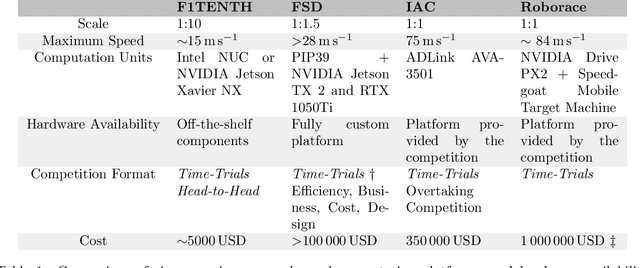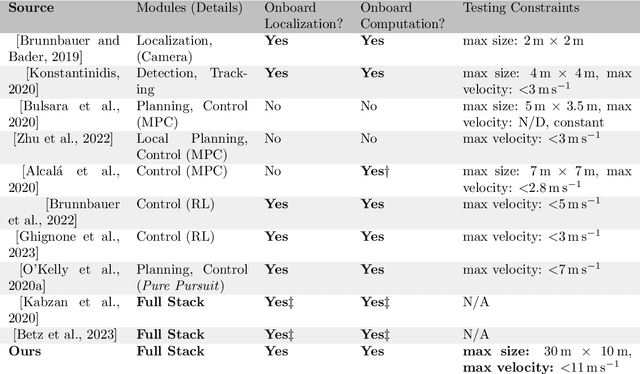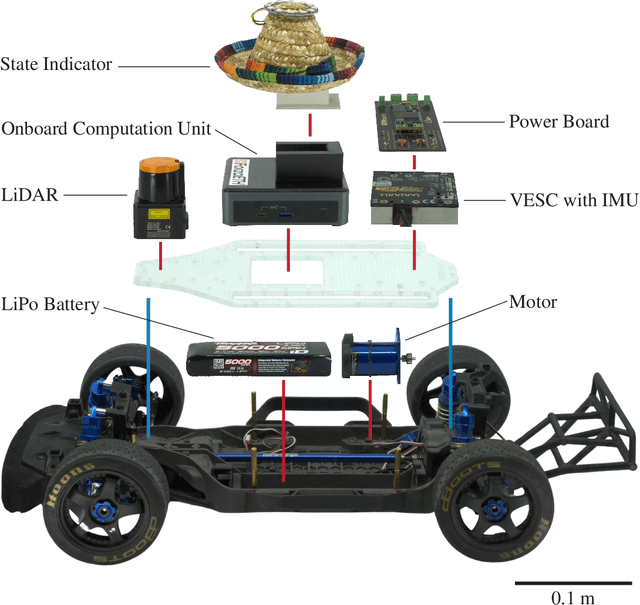Jonathan Becker
ForzaETH Race Stack -- Scaled Autonomous Head-to-Head Racing on Fully Commercial off-the-Shelf Hardware
Mar 18, 2024



Abstract:Autonomous racing in robotics combines high-speed dynamics with the necessity for reliability and real-time decision-making. While such racing pushes software and hardware to their limits, many existing full-system solutions necessitate complex, custom hardware and software, and usually focus on Time-Trials rather than full unrestricted Head-to-Head racing, due to financial and safety constraints. This limits their reproducibility, making advancements and replication feasible mostly for well-resourced laboratories with comprehensive expertise in mechanical, electrical, and robotics fields. Researchers interested in the autonomy domain but with only partial experience in one of these fields, need to spend significant time with familiarization and integration. The ForzaETH Race Stack addresses this gap by providing an autonomous racing software platform designed for F1TENTH, a 1:10 scaled Head-to-Head autonomous racing competition, which simplifies replication by using commercial off-the-shelf hardware. This approach enhances the competitive aspect of autonomous racing and provides an accessible platform for research and development in the field. The ForzaETH Race Stack is designed with modularity and operational ease of use in mind, allowing customization and adaptability to various environmental conditions, such as track friction and layout. Capable of handling both Time-Trials and Head-to-Head racing, the stack has demonstrated its effectiveness, robustness, and adaptability in the field by winning the official F1TENTH international competition multiple times.
Model- and Acceleration-based Pursuit Controller for High-Performance Autonomous Racing
Sep 09, 2022



Abstract:Autonomous racing is a research field gaining large popularity, as it pushes autonomous driving algorithms to their limits and serves as a catalyst for general autonomous driving. For scaled autonomous racing platforms, the computational constraint and complexity often limit the use of Model Predictive Control (MPC). As a consequence, geometric controllers are the most frequently deployed controllers. They prove to be performant while yielding implementation and operational simplicity. Yet, they inherently lack the incorporation of model dynamics, thus limiting the race car to a velocity domain where tire slip can be neglected. This paper presents Model- and Acceleration-based Pursuit (MAP) a high-performance model-based trajectory tracking algorithm that preserves the simplicity of geometric approaches while leveraging tire dynamics. The proposed algorithm allows accurate tracking of a trajectory at unprecedented velocities compared to State-of-the-Art (SotA) geometric controllers. The MAP controller is experimentally validated and outperforms the reference geometric controller four-fold in terms of lateral tracking error, yielding a tracking error of 0.055m at tested speeds up to 11m/s.
 Add to Chrome
Add to Chrome Add to Firefox
Add to Firefox Add to Edge
Add to Edge